- Home
- Tony Hillerman
Talking God jlajc-9
Talking God jlajc-9 Read online
Talking God
( Joe Leaphorn and Jim Chee - 9 )
Tony Hillerman
TALKING GOD
Tony Hillerman
Leaphorn & Chee 10
EBook Design Group digital back-up edition v1 HTML
March 14, 2003
Contents
^
|1| |2| |3| |4| |5| |6| |7| |8| |9| |10| |11| |12| |13| |14| |15| |16| |17| |18| |19| |20| |21| |22|
This is a work of fiction. The characters, incidents, and dialogues are products of the author’s imagination and are not to be construed as real. Any resemblance to actual events or persons, living or dead, is entirely coincidental.
Copyright © 1989 by Tony Hillerman
All rights reserved.
A hardcover edition of this book was published in 1989 by Harper & Row, Publishers, Inc.
Cover illustration by Peter Thorpe
This book is dedicated to Delbert Kedelty, Terry Teller, David Charley, Donald Tsosie, and the other kids at Tsaile School who drew the Yeibichai pictures that started me thinking about Talking God.
And to Will Tsosie, Tsosie Tsinijinnie, Tribal Councilman Melvin Bigthumb, and the others who fight to preserve Hajiinei-Dine’tah and its ruins and pictographs for future generations.
The author is grateful to Caroline L. Rose, Martin Burke, Don Ortner, Jo Allyn Archambault, and other curators, conservators, and generally good people at the Smithsonian’s National Museum of Natural History for putting up with me and giving me some insight into what goes on behind the exhibits at a great museum.
All characters in this book, with the exception of Bernard St. Germain and Ernie Bulow, are figments of my imagination. Some of the job titles are more or less real, but the people who hold them are imaginary.
Chapter One
^ »
Through the doorway which led from her receptionist-secretary’s office into her own, Catherine Morris Perry instantly noticed the box on her desk. It was bulky—perhaps three feet long and almost as high. The legend printed on it said it had originally contained a microwave oven manufactured by General Electric. Strips of brown tape had been wrapped erratically around it. It was a crude box, incongruous amid the pale pastels and tasteful artifacts of Catherine Perry's stylish office.
“How was the weekend?” Markie said.
Catherine Morris Perry hung her raincoat on its peg, hung her rain hat over it, removed the transparent plastic from her shoes, and said, “Hello, Markie.”
“How was Vermont?” Markie asked. “Wet up there, too?”
“Where’d that come from?” Catherine said, indicating the box.
“Federal Express,” Markie said. “I signed for it.”
“Am I expecting anything?”
“Not that you told me about. How was Vermont?”
“Wet,” Catherine said. She did not wish to discuss Vermont, or anything else involving life outside this office, with Markie Bailey. What she did wish to discuss with Markie was taste. Or lack of taste. Putting the big box, brown and ugly, on her antique desk, as Markie had done, was typical of the problem. It squatted there, ugly, obscenely out of place. As out of place as Mrs. Bailey was in this office. But getting rid of her would be almost impossible. Certainly a huge amount of trouble under federal civil service rules. Mrs. Perry’s specialty in law was not personnel, but she had learned something from the efforts to get rid of Henry Highhawk, that troublemaking conservator in the Museum of Natural History. What an unending fiasco that had been.
“You had a call,” Markie said. “The cultural attache’s office at the Chilean embassy. He wanted an appointment.”
“Later,” Catherine Morris Perry said. “I’ll return it later.” She knew what that problem would be. Another Indian-giver problem. General Something-or-Other wanting artifacts returned. He claimed his great-grandfather had only loaned them to some big shot in United Fruit, and he had no right to give them to the Smithsonian, and they were national treasures and must be returned. Incan, as she remembered. Gold, of course. Gold masks, encrusted with jewels, and the general would probably decide they were the general's personal treasure, if he could get his hands on them. And seeing that he didn't meant a huge amount of work for her, research into documents and into international law, which she should get working on right away.
But there sat the box taking up desk space. It was addressed to her as “Museum Spokesperson.” Catherine Morris Perry didn’t like being addressed as “Spokesperson.” That she was so addressed probably stemmed from the statement she'd given the Washington Post on museum policy. It had been more or less an accident, the whole thing. The reporter’s call had been referred to her only because someone was sick in the public affairs office, and someone else was away from his desk, and whoever had handled the call had decided a lawyer should deal with it. It concerned Henry Highhawk again, obliquely at least. It concerned the trouble he was stirring up about returning aboriginal skeletal remains. And the Post had called and identified her incorrectly as spokesperson, and quoted her when they should have quoted the museum board of directors. The policy on skeletons was, after all, official policy of the board. And a sound policy.
The Federal Express shipping order attached to the box was correct except for the erroneous title. She was “Temporary Assistant Counsel, Public Affairs” on loan from the Department of the Interior. She sat and flipped quickly through the remainder of her mail. Nothing much. What was probably an invitation from the National Ballet Guild to an upcoming fund-raiser. Something from the American Civil Liberties Union. A memo from the museum maintenance director telling her why it was impossible for him to deal with a personnel complaint as the law required him to. Another letter concerning insurance for borrowed items going into an exhibit opening next month, and three letters which seemed to be from private outside sources, none familiar.
Catherine Morris Perry put all the envelopes aside unopened, looked at the box, and made a wry face. She opened her desk drawer and extracted her letter opener. Then she buzzed Mrs. Bailey.
“Yes’um.”
“Mrs. Bailey. When packages arrive like this, don’t bring them in and put them on my desk. Open them and get the contents out.”
“Okay,” Mrs. Bailey said. “I’ll open it now. It's a heavy thing.” She paused. “Mrs. Paterson always wanted all the mail put in on her desk.”
“I’ll open it,” Catherine said. “I meant from now on. And Mrs. Paterson is on leave. She is not in charge now.”
“Okay,” Mrs. Bailey said. “Did you notice the telephone messages? Two of them? On your desk, there?”
“No,” Catherine said. They were probably under the box.
“Dr. Hebert called and just said he wanted to congratulate you on the way you handled the skeleton thing. On what you said in the Post.”
With her free hand Catherine Perry was slicing the tape away with the letter opener. She thought that this box was probably a result of that story in the Washington Post. Any time the museum got into the news, it reminded a thousand old ladies of things in the attic that should be saved for posterity. Since she was quoted, one of them had sent this trash to her by name. What would it be? A dusty old butter churn? A set of family albums?
“The other one was somebody in the anthropology division. I put her name on the slip. Wants you to call. Said it was about the Indians wanting their skeletons back.“
“Right,” Catherine said. She pulled open the top flaps. Under them was a copy of the Washington Post, folded to expose the story that had quoted her. Part of it was circled in black.
museum offers compromise in old bone controversy
The headline irritated Catherine. There had been no compromise. She had simply stated the museum’s policy. If a
n Indian tribe wanted ancestral bones returned, it had only to ask for them and provide some acceptable proof that the bones in question had indeed been taken from a burial ground of the tribe. The entire argument was ridiculous and demeaning. In fact, even dealing with that Highhawk man was demeaning. Him and his Paho Society. A museum underling and an organization which, as far as anybody knew, existed only in his imagination. And only to create trouble. She glanced at the circled paragraph.
“Mrs. Catherine Perry, an attorney for the museum and its spokesperson on this issue, said the demand by the Paho Society for the reburial of the museum’s entire collection of more than 18,000 Native American skeletons was ‘simply not possible in light of the museum's purpose.’
“She said the museum is a research institution as well as a gallery for public display, and that the museum’s collection of ancient human bones is a potentially important source of anthropological information. She said that Mr. Highhawk's suggestion that the museum make plaster casts of the skeletons and rebury the originals was not practical ‘both because of research needs and because the public has the right to expect authenticity and not to be shown mere reproductions.’ ”
The clause “the right to expect authenticity” was underlined. Catherine Morris Perry frowned at it, sensing criticism. She picked up the newspaper. Under it, atop a sheet of brown wrapping paper, lay an envelope. Her name had been written neatly on it. She opened it and pulled out a single sheet of typing paper. While she read, her idle hand was pulling away the layer of wrapping paper which had separated the envelope from the contents of the box.
Dear Mrs. Perry:
You won’t bury the bones of our ancestors because you say the public has the right to expect authenticity in the museum when it comes to look at skeletons.
Therefore I am sending you a couple of authentic skeletons of ancestors. I went to the cemetery in the woods behind the Episcopal Church of Saint Luke. I used authentic anthropological methods to locate the burials of authentic white Anglo types—
Mrs. Morris Perry’s fingers were under the wrapping paper now, feeling dirt, feeling smooth, cold surfaces. “Mrs. Bailey!” she said. “Mrs. Bailey!” But her eyes moved to the end of the letter. It was signed
“Henry Highhawk of the Bitter Water People.”
“What?” Mrs. Bailey shouted. “What is it?”
—and to make sure they would be perfectly authentic, I chose two whose identities you can personally confirm yourself. I ask that you accept these two skeletons for authentic display to your clients and release the bones of two of my ancestors so that they may be returned to their rightful place in Mother Earth. The names of these two authentic—
Mrs. Bailey was standing beside her now. “Honey,” she said. “What’s wrong?” Mrs. Bailey paused. “There's bones in that box,” she said. “All dirty, too.”
Mrs. Morris Perry put the letter on the desk and looked into the box. From underneath a clutter of what seemed to be arm and leg bones a single empty eye socket stared back at her. She noticed that Mrs. Bailey had picked up the letter. She noticed dirt. Damp ugly little clods had scattered on the polished desk top.
“My God,” Mrs. Bailey said. “John Neldine Burgoyne. Jane Burgoyne. Weren’t those—Aren't these your grandparents?”
Chapter Two
« ^ »
On the last Thursday in August, the doctor treating Agnes Tsosie in the Public Health Service hospital at Fort Defiance told her she was dying and there was nothing he could do about it.
“I knew that,” Agnes Tsosie said. And she smiled at him, and patted his hand, and asked him to call the chapter house at Lower Greasewood and leave word there for her family to come and get her.
“I won’t be able to release you,” the doctor said. “We have to keep you on medications to control the pain, and that has to be monitored. You won't be able to go home. Not yet.”
“Not ever,” Agnes Tsosie said, still smiling. “But you leave the message for me anyway. And don’t you feel bad about it. Born for Water told Monster Slayer to leave Death alive to get rid of old people like me. You have to make some room for the new babies.“
Agnes Tsosie came home from the hospital at Fort Defiance on the last Monday of August—overriding the objections of her doctor and the hospital establishment by force of the notorious Agnes Tsosie willpower.
In that part of the Navajo Reservation west of the Chuska mountain range and north of the Painted Desert, just about everybody knew about Agnes Tsosie. Old Woman Tsosie had twice served her Lower Greasewood Chapter on the Navajo Tribal Council. National Geographic had used her picture in an article about the Navajo Nation. Her iron will had a lot to do with starting tribal programs to get water wells drilled and water supplies available at every chapter house where hauling drinking water was a problem. Her stubborn wisdom had been important for years among her clansmen, the Bitter Water People. On the Bitter Water Dinee she imposed her rigid rules of peace. Once, she had kept a meeting of two Bitter Water families in session for eleven days until—out of hunger and exhaustion—they settled a grazing rights feud that had rankled for a hundred years.
“Too many people come out of these belagaana hospitals dead,” Agnes Tsosie had told her doctor. “I want to come out alive.” And no one was surprised that she did. She came out walking, helped by her daughter and her husband. She sat in the front seat of her daughter’s pickup, joking as she always did, full of teasing and funny stories about hospital behavior. But on the long drive through the sagebrush flats toward Lower Greasewood the laughter died away. She leaned heavily against the pickup door and her face was gray with sickness.
Her son-in-law was waiting at her hogan. His name was Rollie Yellow and Agnes Tsosie, who liked almost everyone, liked Yellow a lot. They had worked a way around the Navajo taboo that decreed sons-in-law must avoid mothers-in-law. Agnes Tsosie decided that role applied only to mean mothers-in-law with bad sons-in-law. In other words, it applied to people who couldn’t get along. Agnes Tsosie and Yellow had gotten along wonderfully for thirty years and now it was Yellow who half carried her into her summer hogan. There she slept fitfully all afternoon and through the night.
The next morning, Rollie Yellow made the long bumpy drive around the mesa to the Lower Greasewood Chapter House and used the telephone. He called the chapter house at Many Farms and left word that Nancy Yabenny was needed.
Nancy Yabenny was a clerk-typist in the office of the Navajo Timber Industries and a crystal gazer—one of the category of Navajo shamans who specialize in answering hard questions, in finding the lost, in identifying witches, and in diagnosing illnesses so that the proper curing ceremonial can be arranged.
Nancy Yabenny arrived Thursday afternoon, driving a blue Dodge Ram pickup. She was a plump, middle-aged woman wearing a yellow pantsuit which had fit her better when she was slimmer. She carried her crystal, her four- mountains bundle, and the other paraphernalia of her profession in a briefcase. She placed a kitchen chair in the shade beside Agnes Tsosie’s bed. Yellow had moved the bed out of the hogan into the brush arbor so that Agnes Tsosie could watch the thunderclouds form and blow away above the Hopi Buttes. Yabenny and Old Woman Tsosie talked for more than an hour. Then Nancy Yabenny arranged her slab of crystal on the earth, took her jish of sacred things out of her purse, and extracted from it a prescription bottle filled with corn pollen. She dusted the crystal with that, chanted the prescribed blessing song, held it so that the light from the sky illuminated it, and stared into it.
“Ah,” she said, and held the crystal so that Agnes Tsosie could see what she was seeing.
Then she questioned Agnes Tsosie about what they had seen.
It was sundown when Nancy Yabenny emerged from the brush arbor. She talked to Tsosie’s husband and daughter and to Rollie Yellow. She told them Agnes Tsosie needed a Yeibichai to be restored to harmony and beauty.
Rollie Yellow had half expected that, but still it was a blow. White men call it the Night Chant, but the ceremoni
al was named for its principal participant—Yeibichai, the great Talking God of Navajo metaphysics. As the maternal grandfather of all the other gods, he often serves as their spokesman. It is an expensive ceremony, nine days and nights of feeding the audience of clansmen and friends, and providing for the medicine man, his helpers, and as many as three teams of yei dancers. But much worse than the expense, in the mind of Rollie Yellow, was that what Yabenny had told them meant the belagaana doctor was probably right. Agnes Tsosie was very, very sick. No matter the cost, he would have to find a singer who knew how to do the Night Chant. Not many did. But there was time. The Yeibichai can be performed only after the first frost, after snakes have hibernated, only in the Season When Thunder Sleeps.
Chapter Three
« ^ »
I heard you decided not to quit,” Jay Kennedy said. “That right?”
“More or less,” Lieutenant Joe Leaphorn said.
“Glad to hear it. How busy are you?”
Leaphorn hesitated, his eyes flicking over the pile of paperwork on his desk, his mind analyzing the tone of Kennedy’s voice on the telephone.
“Nothing unusual,” he said.
“You heard about this body out east of Gallup?”
“I heard a something-or-other,” Leaphorn said—which meant a secondhand report of what had been overheard by the radio dispatcher downstairs. Just enough to know it wasn’t a routine body find.
“It may not be Bureau business,” Kennedy said. “Except technically. But it’s interesting.”
Which was Kennedy’s way of saying he thought it soon would be his business. Kennedy was Gallup area Federal Bureau of Investigation, and had been a friend of Leaphorn's long enough so that such things no longer had to be exactly said.
“The way I heard it, they found him beside the railroad,” Leaphorn said. “That would be off the reservation. None of our business either.”

 People of Darkness
People of Darkness Talking God jlajc-9
Talking God jlajc-9 Skinwalkers jlajc-7
Skinwalkers jlajc-7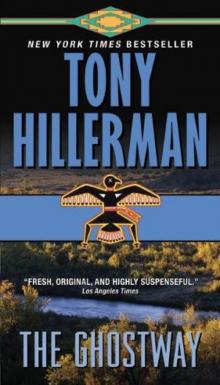 The Ghostway jlajc-6
The Ghostway jlajc-6 The Dark Wind jlajc-5
The Dark Wind jlajc-5 The Blessing Way
The Blessing Way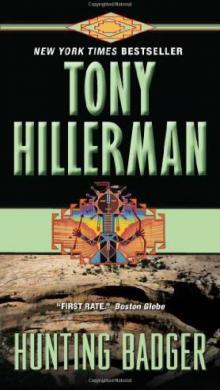 Hunting Badger jlajc-14
Hunting Badger jlajc-14 Seldom Disappointed: A Memoir
Seldom Disappointed: A Memoir Coyote Waits jlajc-10
Coyote Waits jlajc-10 Skeleton Man jlajc-17
Skeleton Man jlajc-17 The Shape Shifter
The Shape Shifter Sacred Clowns jlajc-11
Sacred Clowns jlajc-11 The Fallen Man jlajc-12
The Fallen Man jlajc-12 The First Eagle jlajc-13
The First Eagle jlajc-13 Listening Woman jlajc-3
Listening Woman jlajc-3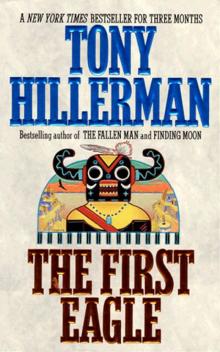 The First Eagle
The First Eagle Skeleton Man
Skeleton Man The Sinister Pig jlajc-16
The Sinister Pig jlajc-16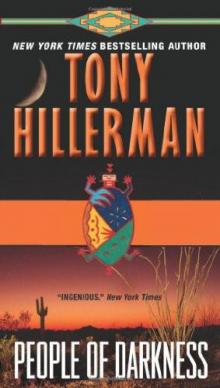 People of Darkness jlajc-4
People of Darkness jlajc-4 The Blessing Way jlajc-1
The Blessing Way jlajc-1 A Thief of Time
A Thief of Time The Wailing Wind
The Wailing Wind A Thief of Time jlajc-8
A Thief of Time jlajc-8 The Wailing Wind jlajc-15
The Wailing Wind jlajc-15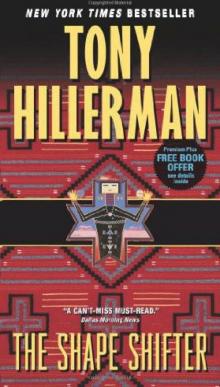 The Shape Shifter jlajc-18
The Shape Shifter jlajc-18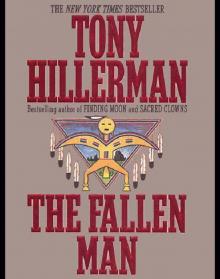 The Fallen Man
The Fallen Man Finding Moon
Finding Moon